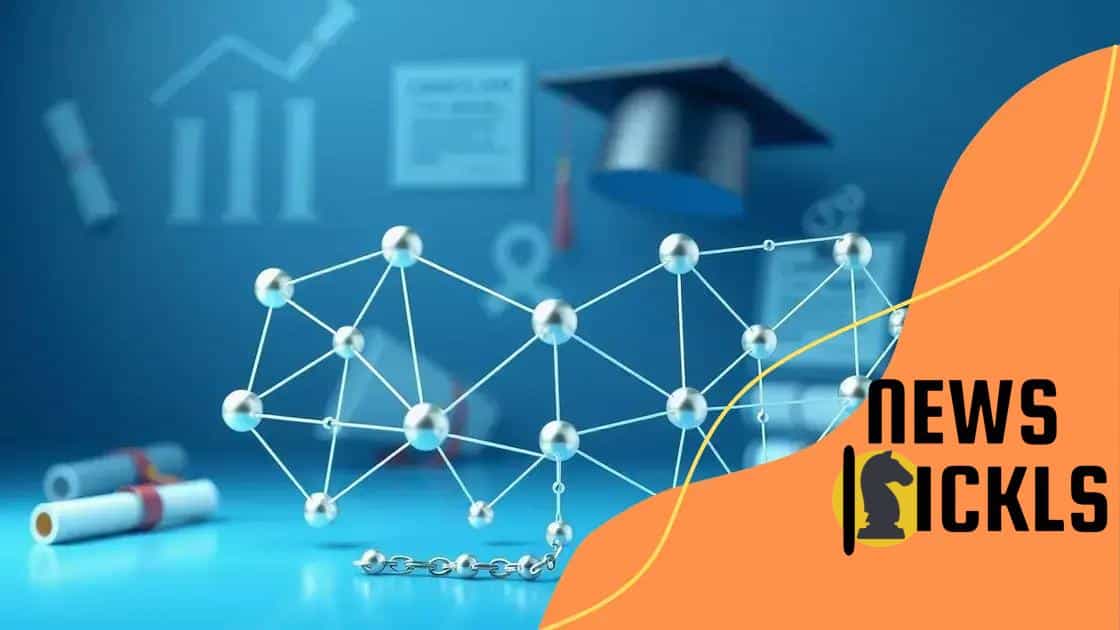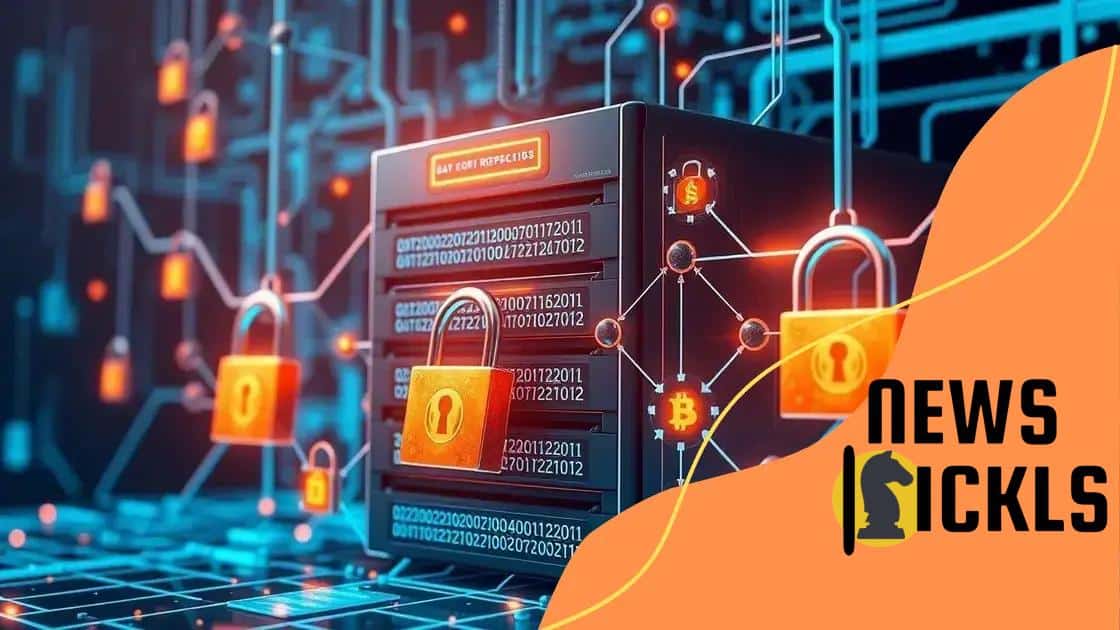How blockchain is enabling transparency in educational credentials

Blockchain enhances transparency in educational credentials by providing secure, verifiable records that streamline the credential verification process, thereby improving trust between employers and candidates.
How blockchain is enabling transparency in educational credentials is reshaping the way we verify academic achievements. Imagine a world where your degree’s authenticity is just a click away, making the hiring process smoother for everyone. Let’s dive into this exciting transformation!
Understanding blockchain technology
Understanding blockchain technology is essential to grasp how it revolutionizes various sectors, particularly education. At its core, blockchain is a decentralized digital ledger that records transactions across many computers. This ensures that the records cannot be altered retroactively. The transparency and security offered by blockchain make it a powerful tool for verifying educational credentials.
Key Features of Blockchain
Blockchain operates on several key principles that enhance its functionality:
- Decentralization: Unlike traditional databases, a blockchain is decentralized, meaning no single entity controls it.
- Immutability: Once data is recorded on the blockchain, it cannot be changed, which guarantees the integrity of information.
- Transparency: All transactions are visible to all participants, improving trust among stakeholders.
- Security: Advanced cryptography secures data, making it extremely difficult for unauthorized users to alter records.
As we explore these features, it’s important to consider how they contribute to the educational sector. Schools and universities can maintain a digital record of degrees and achievements that is secure and easy to access for employers and students alike. This ensures that the credentials are verified in real-time, enhancing the trust factor in the hiring processes.
Additionally, the use of smart contracts within blockchain technology can automate verification processes. For instance, they can trigger actions once specific criteria are met without the need for a middleman. This not only speeds up the verification but also reduces costs, thereby making the entire system more efficient.
Advantages of Blockchain in Education
By understanding blockchain technology, educators and institutions can leverage its advantages:
- Improved efficiency: Streamlined processes lead to quicker results in credential verification.
- Reduced fraud: Fraudulent claims of educational achievements are minimized.
- Global accessibility: Credentials can be accessed by anyone, anywhere, at any time.
The implications of adopting such technology in education are immense. As more institutions start to recognize its potential, we could witness a transformation that not only enhances transparency but also builds a more reliable system for educational credentials.
The challenges of traditional credential verification
Traditional credentials verification faces numerous challenges that hinder efficiency and trust in the educational sector. Many institutions rely on outdated methods that slow down the hiring process. Verifying degrees typically requires manual checks, which can take a long time and may lead to human errors.
Common Issues in Credential Verification
Some of the most pressing issues include:
- Time-consuming processes: Traditional methods can take weeks or even months to complete.
- High costs: Institutions spend significant resources on verification, diverting funds from more impactful areas.
- Fraud susceptibility: Fake degrees and transcripts are increasingly common, making it difficult to determine the authenticity of credentials.
- Lack of standardization: Each institution has its own processes, which can lead to inconsistencies in verification.
These challenges not only affect students and graduates but also pose risks for employers looking to verify qualifications quickly. The longer it takes to validate a candidate’s credentials, the more likely they are to lose out on top talent. This inefficiency can create frustration for both job seekers and hiring managers.
In addition to the logistical hurdles, trust becomes a significant factor in traditional systems. Employers often face uncertainty regarding whether the credentials presented are genuine. This can lead to hesitation in hiring, impacting overall workforce dynamics.
The Need for Improvement
To address these challenges, the education sector must adopt new technologies that streamline the verification process. By leveraging blockchain technology, institutions can provide secure, instant access to verified credentials. This shift can potentially eliminate many of the challenges associated with traditional verification methods.
Transforming the verification process not only improves efficiency but also enhances trust among employers. As more effective systems emerge, the cycle of fraudulent credentials may diminish, promoting integrity across the educational landscape.
How blockchain enhances data security

How blockchain enhances data security is a crucial topic in understanding its applications across various sectors, especially education. Blockchain technology is built on a foundation of transparency and security that traditional methods often lack. It provides a decentralized way to store and manage data, significantly improving how information is protected.
Key Aspects of Blockchain Security
Several features of blockchain technology contribute to enhanced data security:
- Decentralization: Data is not stored in a single location, reducing vulnerability to hacks and attacks.
- Encryption: Advanced cryptographic techniques ensure that data is secure and only accessible to authorized users.
- Consensus mechanisms: Transactions must be agreed upon by a majority, preventing unauthorized changes to data.
- Audit trails: Every transaction is recorded, making it easy to trace and validate the history of data changes.
These features ensure that institutions can store sensitive information, such as academic credentials, without fear of unauthorized access. Unlike conventional databases, where a breach could compromise vast amounts of data, a blockchain’s distributed nature means a hacker would need to control a significant part of the network to manipulate the information.
Moreover, when academic records are stored on a blockchain, students and employers have confidence that the data is accurate and intact. This trust is vital for the credibility of educational institutions and the value of their degrees. When employees are assured of their candidates’ true qualifications, it can lead to a more robust hiring process.
The Role of Smart Contracts
Another way blockchain enhances data security is via smart contracts. These self-executing contracts automatically enforce terms and conditions without needing intermediaries. By using smart contracts, educational institutions can automate the verification of credentials, which minimizes human error and ensures compliance with set standards.
In a world where data breaches are all too common, blockchain technology not only secures academic records but also reflects a broader commitment to integrity and transparency in education. As adoption increases, it may very well become the standard for data security across various fields.
Real-world applications in education
Real-world applications in education illustrate how blockchain technology can transform the way institutions verify credentials and manage records. Various educational organizations are beginning to harness its power for a range of functions that enhance transparency and security.
Credential Verification
One of the most notable applications of blockchain in education is in credential verification. Educational institutions can issue degrees and transcripts on a blockchain, allowing for a secure and verifiable way to confirm a student’s academic achievements.
- Immediate verification: Employers can instantly verify a candidate’s credentials, eliminating delays in the hiring process.
- Reduced fraud: Storing records on a blockchain minimizes the risk of fraudulent diplomas and fake transcripts.
- Ease of access: Students can share their verified credentials easily with educational or professional institutions.
These features not only expedite the verification process but also build confidence between employers and potential hires.
Learning Management Systems
Another significant use of blockchain is in learning management systems (LMS). Some institutions are exploring how blockchain can help track student progress and achievements. By recording every interaction in an LMS on a blockchain, education providers can obtain transparent records of each student’s learning journey.
This method allows for personalized learning paths, as students can receive tailored feedback based on their individual progress. Moreover, it ensures that all achievements are documented accurately, offering a comprehensive overview that reflects the learner’s capabilities.
Decentralized Education Platforms
Blockchain also enables the creation of decentralized education platforms. These platforms can provide courses and certifications without the need for a central authority. This radically changes the landscape by making education more accessible to individuals worldwide, irrespective of their location or financial resources.
Students can enroll in courses directly from educators, and their achievements are recorded securely on the blockchain. This approach encourages lifelong learning and allows teachers to build their own brands and reach a global audience.
Micro-Credentials
Micro-credentials are another exciting application made possible by blockchain technology. Educational institutions can issue smaller, more specific credentials that highlight particular skills or achievements. This flexibility allows students to showcase their competencies in a detailed manner, improving their employability.
With blockchain, micro-credentials are easily verifiable and portable. Students can hold multiple credentials from different providers, showcasing their unique skill sets and experiences to prospective employers.
Future implications for employers and educators
Future implications for employers and educators highlight how blockchain technology will reshape the educational landscape in the coming years. As more institutions adopt blockchain, both educators and employers will encounter significant changes in how they approach credentials and qualifications.
Changing Hiring Practices
Employers will need to adapt their hiring practices to include blockchain-verified credentials. This technology allows for instant verification of a candidate’s qualifications. By utilizing blockchain, businesses can:
- Reduce hiring time: Recruiters can quickly confirm whether candidates possess the necessary skills and degrees.
- Enhance trust: With transparent records, employers will feel more confident in the validity of the credentials presented.
- Expand candidate pools: As hiring becomes easier, employers can consider applicants from a broader range of backgrounds and experiences.
This evolution will likely lead to more efficient hiring processes and help organizations find the best talent faster.
Educational Institutions’ Roles
Educational institutions will also experience profound changes as they embrace blockchain technology. They will need to ensure that their systems integrate with blockchain platforms to provide secure recording of student achievements.
As institutions adapt, they may:
- Offer new programs: The demand for micro-credentials and specialized skills will grow, leading institutions to create tailored programs.
- Streamline administrative processes: Automation through blockchain will reduce bureaucratic inefficiencies.
- Build global networks: Schools can collaborate across borders, sharing resources and courses to enhance student learning.
The way universities and colleges present their value will change too. Rather than just offering degrees, they may focus on showcasing a student’s entire learning journey documented on the blockchain.
Long-term Impacts on Learning
The long-term impacts of these changes will foster a more dynamic and adaptable educational system. Students will benefit from personalized learning experiences, and their accomplishments will be easily verifiable by employers. The emphasis on lifelong learning will increase, as individuals may continuously build on their skills through blockchain credentials.
This shift will not only enhance transparency in the educational system but also support workforce readiness in an ever-evolving job market. As blockchain continues to develop, its influence on education will undoubtedly create a more informed and skilled labor force.
FAQ – Questions about blockchain’s impact on education
How does blockchain improve credential verification?
Blockchain provides a secure, transparent method to verify credentials instantly, reducing fraud and speeding up hiring processes.
What benefits does blockchain offer for employers?
Employers can trust the validity of candidate qualifications, leading to quicker hiring times and a more efficient recruitment process.
How can educational institutions benefit from blockchain?
Educational institutions can automate administrative processes, enhance student record accuracy, and offer tailored learning paths.
What is the significance of lifelong learning in a blockchain-enabled world?
Lifelong learning encourages continuous skill development, allowing individuals to earn verifiable credentials as they progress in their careers.






